How strong sector fundamentals and sophisticated design buoy Miami’s real estate market in trying times
Edgardo Defortuna President & CEO – Fortune International Group
Given that Miami’s real estate sector relies heavily on international buyers, how has the local market been impacted by a strong U.S. dollar?
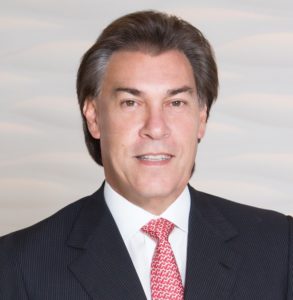 Miami is particularly sensitive to events taking place in other parts of the globe—whether this pertains to currency exchange rates or government policies. At Fortune, we believe that the world is in love with Miami so we don’t worry so much about what is happening in particular countries; rather, we focus our efforts on opening up new markets and forging new partnerships with those who may still be unfamiliar with Miami. Everyone wants a piece of the Miami pie. Our job is to find the right mix and the right timing for them.
Miami is particularly sensitive to events taking place in other parts of the globe—whether this pertains to currency exchange rates or government policies. At Fortune, we believe that the world is in love with Miami so we don’t worry so much about what is happening in particular countries; rather, we focus our efforts on opening up new markets and forging new partnerships with those who may still be unfamiliar with Miami. Everyone wants a piece of the Miami pie. Our job is to find the right mix and the right timing for them.
Miami’s strategic location and good climate are no doubt attracting investors and buyers. What role do the actual buildings in the market play in elevating Miami’s global profile?
Developers today are not just concerned with how buildings look from the exterior, but also with how they function and interact with the environment. For instance, thorough sun studies are conducted, especially for buildings on the beach, to analyze how shadows are created and to ensure that said shadows do not render certain areas, like the pool, unusable after 1 o’clock.
We are also seeing innovations that make more efficient use of space. For example, our architecture partners Herzog and de Meuron came up with the brilliant idea for our Jade Signature project in Sunny Isles to put the parking underground—40 feet under water that is. It makes a big difference and makes everything in the building work—the integration of the pool, the beach, the restaurants and all the amenities. It really makes a difference in the lifestyle of the consumers. Having this level of attention to detail makes for really spectacular buildings and makes Miami far more attractive to a larger audience.
What are the greatest concerns facing Miami’s real estate market?
I worry most about perception because perception becomes reality. The media and others who report on this market often do not understand how the new financing model in Miami is working. They talk about a supply of 10,000 or 15,000 units, but don’t mention that 80 percent to 90 percent of those units have already been sold, with 50 percent deposit. Those deposits are used to finance construction so the leverage today is significantly below what it was in the previous cycle. We are financing less that 30 percent of costs through bank leverage, and these are signs of a healthy market.
How Miami’s world-class assets boost the long-term prospects of its real estate market
Carlos Rosso President of Condominium Development – The Related Group
What strategies have developers employed to adapt to a more challenging real estate market?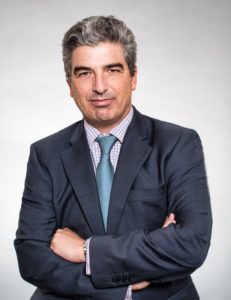
Identifying and tapping into new markets is very important to us. We travel to different countries to connect with potential buyerswho have the means and desires to live in and purchase in Miami. We are paying close attention to the Mexican market aswell as several smaller wealth centers such as Bolivia’s Santa Cruz de la Sierra.
Strong North American economies mean we can continue to source new buyers from the U.S. and Canada, and we continue to offer the best in design, amenities and locations to attract local buyers.
We are also about to launch new micro unit developments to appeal to Downtown Miami’s new younger demographic.
Bottom line, successful developers are those capable of adapting to market conditions quicker than others.
In what areas is Related looking to direct its e orts and investments?
We are looking at possible development sites in the neighborhoods of Wynwood and Edgewater and continuing projects in Coconut Grove and Sunny Isles. We are also focusing on developing the market for smaller apartments as we’ve noticed a large audience for them. There is a high demand for these units from local buyers because of the lower prices. At the same time, we are also looking at sites in Miami-Dade to develop luxury condominiums at $575 per square foot and $700 per square foot.
What challenges must urgently be addressed for Miami-Dade to continue on its growth trajectory?
The good news is that, compared to international cities like Los Angeles and New York, Miami offers the best value for real estate and is growing faster than any other city. Part of the allure is that more than a dozen world-renowned architects are living and working in Miami, attracting international buyers searching for a different look not found anywhere else in the world. They are looking for the best, and Miami is offering it. In fact, last year, we saw buyers of nearly 300 different nationalities, solidifying Miami’s reputation as a premier real estate destination. The biggest challenge now is to create a larger salary base that can support the real estate we’re building. The more cultural offerings there are in South Florida, the more the area will attract intelligent people to live and work here. Miami sells itself on its natural beauty, as the beaches and the weather are popular reasons people come to Miami. However, we also need to portray ourselves as a world-class city, whose identity is not so much rooted in having a good time or being retired, as much as it is in being a professional center attracting the best in nance, banking and innovation.
Invest: Miami speaks with Ozgur Atlan, Consul-General of Turkey in Miami
The opening of a Turkish consulate in Miami is part of Turkey’s strategic plan to expand its commercial, diplomatic and consular presence in the U.S., and to deepen ties to the Caribbean and South America; the Turkish government recognized that to be successful in Latin America it must have a presence in Miami. To fulfill our goals in Miami, we worked to bring Turkish Airlines back to Miami International Airport after 14 years. Direct flights to Istanbul commenced in late 2015. Our next step is to improve our commercial ranking in doing business within the city and the State of Florida. Miami is strong in real estate, tourism, hospitality, aerospace technology and medical equipment and has much to offer Turkey in those areas in terms of mutual trade.
There is already significant business being done with Turkey in Florida, especially in construction: a great deal of stone and marble—key Turkish exports—are being imported by major Florida cities. Other significant Turkish entries into the local market include a multimillion-dollar car modi cation center in Miami; Turkish conglomerate Suzer Group’s joint venture to develop a luxury hotel in Surfside; and the opening of Okan International University’s campus in North Miami. Turkey has also worked to established its local cultural footprint; for the past five years, Miami has hosted the Turkish Film Festival.
As an international medical tourism and cruise destination, and the sixth most-visited country in the world in 2014, Turkey shares many similarities with Miami, and there are many areas of collaboration between the two places. For instance, Miami has a vibrant cruising industry and serves as the headquarters of three of the major global cruise corporations. Since three out of four tourists traveling to Turkey are doing so to take a cruise, we see many opportunities for strategic cooperation. Turkey also has a thriving jewelry industry; with the continued growth of luxury shopping destinations, like the Miami Design District, there will be more Turkish participation. The cultural and commercial affinities between Turkey and Florida will only create more opportunities for growth and increased cooperation.
Invest: Miami speaks with Louise Leger, Consul-General of Canada in Miami
The bilateral economic relationship between Canada and the U.S. is the largest in the world, valued at $759 billion per year. Florida’s share of that is roughly $8 billion. When we look at industries like tourism and real estate, we see that the impact is not insignificant. Each year, 4 million Canadians visit Florida. Considering Canada’s population of 35 million, that means that one in nine Canadians visit Florida annually. These visitors don’t just come for a long weekend; they stay for months at a time and spend $4.4 billion annually in the state. Canadians are also big real estate investors in Florida. Currently, there are between 500,000 to 600,000 Canadian homeowners in the state, a portfolio that is worth roughly $60 billion.
In addition to the attractive lifestyle that Florida offers to Canadians, there are growing business opportunities present in this market. One top-of-mind issue for South Florida is climate change, and Canada has much expertise in issues related to the environment and energy. Around 45 percent of the oil the U.S. imports comes from Canada, and equally important, Canada exports a great deal of electricity, much of which is renewable, whether it is hydro, wind or solar. Canada is also advanced in the treatment of water and wastewater. Moreover, as South Florida looks to build new infra- structure or replace aging infrastructure, it can bene t from Canadian expertise in the area of public-private partnerships (PPP). Not only does Canada have experience with utilizing PPPs to create roads and bridges, it also has much knowledge of using them for cultural infrastructure—schools, libraries, courthouses—which have different revenue-generation models.
This expertise has attracted the attention of companies active in Florida. NextEra Energy, the parent company of Florida Power and Light (FPL), has been making serious investments in Canada. In November 2015, the Everglades Foundation signed a memorandum of understanding with the Canadian province of Ontario to launch a multi-year effort to design cost-effective technology for the removal of excess phosphorus from freshwater bodies. As Miami continues to develop itself as a hub for technology and innovation, there will be even more opportunities for Canadian investments
Invest: Miami speaks with Marcelo Giusto, Consul-General of Argentina in Miami
Miami has always been in the minds and hearts of Argentines, as shown by the fact that more than 427,000 Argentines arrived at the Miami International Airport in 2014. One of the advantages of this connectivity is it provides opportunities for Argentines to expand their businesses here. Many Argentine businesses are installing their regional headquarters in Miami to attract business from the U.S., the Caribbean and Latin America. The Argentine entrepreneur spirit is strongly felt in Miami-Dade County, where, for instance, there are hundreds of SME’s and startups driven by our nationals. Miami is a natural launch pad for Argentine entrepreneurs to take their first step into the U.S.
The cooperation between authorities in Argentina and Miami helps to facilitate the arrival of approximately 70 small Argentine businesses per year to showcase their products and services across Miami’s top conventions and participate in B2B matchmaking events organized by the Consulate of Argentina. Meanwhile our country continues to seek to balance our trade de cit, with particular respect to the Miami Customs District, currently Argentina’s largest U.S. partner in millions of dollars of total trade. In addition to the products that have historically enjoyed great success in Florida such as wines, berries and leather related products, increasingly more Argentine companies in the creative and tech-driven industries are offering their services in Miami. Companies with expertise in digital marketing, audiovisual, media creation and software development, among others, are finding favorable market conditions in Miami.
The fact that Miami has a great number of Argentines in key leadership positions across multinationals, academia, the arts and health care among other sectors has allowed us to create a networking platform to promote Argentina in the local community throughout its people as well as provide Argentine companies opportunities to establish key relationships in this new market. As Argentina works toward strengthening its relationship with the U.S., it will continue to utilize Miami, Buenos Aires’ sister city, as a hub for its economic and cultural initiatives.
Invest: Miami speaks with Larry K. Williams, Former President and CEO
The economy in Miami-Dade is deeper and broader than people know. It includes a rich history in industries such as aviation, banking and trade and logistics. Today, we continue to see growth in these traditional sectors, but other knowledge-based areas, such as technology, life sciences and health care are also growing rapidly.
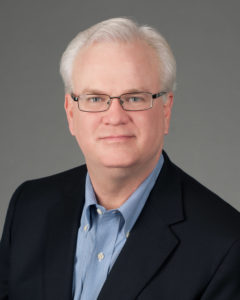
Miami is a natural for growing an innovation ecosystem. Many people may not realize this, but Miami is a “college town,” with over 250,000 students and two research universities. With leading organizations like eMerge Americas, Endeavor and the Knight Foundation investing in entrepreneurship activity, there’s a growing movement and an energy that is exciting and inspiring.
We also see great potential with the designation of Miami International Airport (MIA) as one of only two approved pharmaceutical hubs in the world. To ensure talent development in these critical industries, we have the Academic Leaders Council, an unprecedented collaboration between the presidents of major higher education institutions and the superintendent of schools. They are working directly with business leaders to ensure academic curriculum meets the needs of our businesses. One result of this is the Talent Development Network, a platform to connect employers with students looking for internships.
Global changes impact Miami’s economy as much or more than any other U.S. community. Miami-Dade continues to be a gateway for investment to the U.S. and the region. Our world-class infrastructure is getting even better, with MIA breaking records in passenger and cargo transported, and PortMiami ready to welcome mega-size cargo ships from the expanded Panama Canal. Over 50 percent of all companies coming to Miami are international. For these reasons, marketing Miami-Dade as a world-class business destination is The Beacon Council’s top priority. We continue to focus on countries in Europe and in Latin America, but we are also gaining much more interest from countries in the Middle East and Asia.
How the public sector is strategizing to make Miami a competitive global metropolis
Carlos A. Gimenez,Mayor – Miami-Dade County
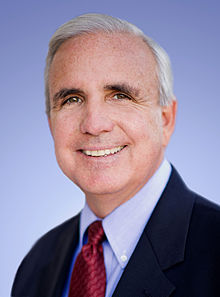 What have been the most significant highlights in Miami-Dade County’s development from 2015?
What have been the most significant highlights in Miami-Dade County’s development from 2015?
Every day, we continue to invest in making Miami-Dade County a world-class community for our residents to live, work and play. For the first time, Miami-Dade has a balanced five-year forecast. We continue to lead the state in private-sector job creation. We have made significant investments in our infrastructure, which have yielded improved mobility and sustainability. We have invested in equipping our police department with body cams and hiring more officers to create a safer community. We have also invested in our parks system and cultural offerings.
As Miami-Dade continues to grow, how have the strategies for urban planning evolved?
The unique challenge to Miami-Dade County when it comes to planning is how to retrofit a relatively low-density sprawled environment to one that provides for urban and cultural centers and to reduce the reliance on the automobile. The county is tackling this challenge in various ways, primarily by shifting land-use policies to encourage intensification around existing public transportation corridors. We are increasing residential densities in these areas, in conjunction with mixing of commercial uses and relief of old and outdated zoning controls. This promotes the development of medium to higher density communities, which not only provide for urban living opportunities, but also for cultural and inclusive communities that promote economic opportunities, a mixture of housing and a sense of place, all while utilizing existing infrastructure.
Workforce development is continually cited as a number-one problem for this county. How does the reality differ from the misperception?
Miami-Dade County has a multi-dimensional workforce, supported by one of the best public school systems and some of the most esteemed educational institutions in the country. Our workforce is uniquely multilingual and multicultural and represents numerous nationalities. Miami-Dade’s recognition as the Gateway to the Americas has further enhanced our position as a global marketplace where professional local talent is readily available to compete and expand businesses worldwide, especially with Latin America and the Caribbean. Under our “One Community One Goal” economic strategy, developed by The Beacon Council, businesses, governments and educational partners have united and conceptualized an approach for developing and retaining talent while building economic opportunities to ensure our current and future growth in industries across a broad spectrum.
How state initiatives are bringing new jobs and diverse investments to Miami-Dade
Rick Scott, Governor – State of Florida
In your State of the State address, you announced an additional $250 million of incentives through the Florida Enterprise Fund. How is this initiative creating jobs in Florida and impacting Miami-Dade?
The purpose of the Florida Enterprise Fund is to recruit companies to move to or expand in Florida. So far, we’ve been able to add 1.25 million jobs in the first five years of the initiative, including 18,000 new jobs in Miami-Dade from November 2014 to November 2015, bringing the county unemployment rate to 5.8 percent. We are ahead of economically significant states in job growth and have become the third-fastest growing job market in the country.
My administration’s job-growth goals include diversifying our economy by attracting more manufacturing and high-tech jobs through reducing taxes and making it easier to do business. For example, there is no sales tax for a three-year period when a manufacturer buys equipment, and we are working to make this permanent. In addition, we are working on removing the sales tax on commercial leases and the income tax for manufacturers and retailers.
We are also focusing on funding higher education to ensure that it caters to the jobs of the future. Florida International University and Miami Dade College are currently doing a great job teaching technology and innovation, and even Miami-Dade’s public school system is educating for the future by creating specialized business and technology programs.
What changes are being made to attract foreigners to Florida?
Florida is the most important state in the country because of its unique melting pot, which includes one of the world’s most vibrant and international cities, Miami. To continue attracting international residents, we need to make them feel welcome. This is why I’ve focused on keeping our crime rate low by implementing standards to hire the best sheriffs and police chiefs. We are also making communication as smooth as possible so law enforcement is more coordinated and implemented more effectively. We’ve reached a 44-year low in the state’s crime rate, which dropped 4.9 percent between 2013 and 2014.
Miami-Dade has seen an increase in foreign investment. How is Miami-Dade making itself more attractive for foreign direct investment?
Completing the PortMiami Deep Dredge project in 2015 and the Port Tunnel in 2014 were significant shows of support to invite global trade and business. Miami is the first port on the U.S. Eastern Seaboard prepared for the Panama Canal expansion. Accommodating more ships means more investment in PortMiami, opening more routes and increasing commerce and the transfer of goods.
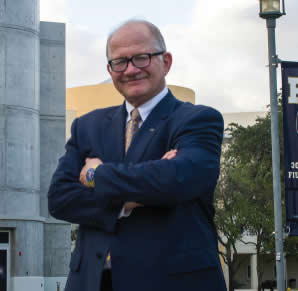
Florida International University (FIU) President Dr. Mark Rosenberg speaks on the role of public-private partnerships in enhancing higher education and workforce development
What are the most urgent priorities when it comes to workforce development?
Miami has historically been a net importer of talent from either the northeastern U.S. or the Southern Hemisphere. While this is a competitive advantage, we also need to establish our own talent base. The Beacon Council’s One Community One Goal Academic Leaders Council, which I chair, is focusing on developing internship programs in conjunction with private sector employers. Because of the velocity of change in the occupational spectrum, universities are limited in their ability to train graduates into the specific niches this global economy is creating; the applied dimension can come only through the internship modality. Improving the level of talent in the workforce is a shared responsibility between the universities and the private sector.
How would you comment on the university’s ability to attract talent – faculty, fellows, researchers, etc.?
We have hired 500 new faculty in the last five years, across all departments, but the issue is not talent acquisition; it is talent retention. Maintaining laboratories and infrastructural support to retain the best talent is a costly enterprise and we are becoming more competitive in those areas. This is why we have been building so much – we’ve either finished or started roughly $349 million worth of construction projects in the past five years.
Can you speak to the funding landscape for public universities in Florida?
We created a forefront funding offensive that maximizes the state support we receive, while more aggressively fundraising through philanthropy, establishing private sector partnerships and competing for federal research dollars. Our budget has grown by about 25 percent in the last five years. We supported that through tuition increases in recent years, but that era is largely over. Additionally, we have benefitted from the enrollment of 14,000 new students and the savings from efficiencies we have been able to drive, particularly in the area of energy.
In which programmatic areas does FIU excel?
Academically, we have identified four strategic thematic areas to focus on: international/global studies, environment, health and the arts. In those areas, we are strong, as well as in hospitality, accounting, management, and liberal arts. Moreover, our geography and our demography are our destiny. As such, we have a strong international element. FIU has the second-largest number of foreign students in Florida. We have worked in Latin America for over 40 years, and have a strong name in the region for our administration of justice and democracy initiatives. We also have a campus in Tianjin, China, which awards FIU degrees to 1,100 Chinese students and focuses largely on hospitality and tourism management.
 Miami is particularly sensitive to events taking place in other parts of the globe—whether this pertains to currency exchange rates or government policies. At Fortune, we believe that the world is in love with Miami so we don’t worry so much about what is happening in particular countries; rather, we focus our efforts on opening up new markets and forging new partnerships with those who may still be unfamiliar with Miami. Everyone wants a piece of the Miami pie. Our job is to find the right mix and the right timing for them.
Miami is particularly sensitive to events taking place in other parts of the globe—whether this pertains to currency exchange rates or government policies. At Fortune, we believe that the world is in love with Miami so we don’t worry so much about what is happening in particular countries; rather, we focus our efforts on opening up new markets and forging new partnerships with those who may still be unfamiliar with Miami. Everyone wants a piece of the Miami pie. Our job is to find the right mix and the right timing for them.


 What have been the most significant highlights in Miami-Dade County’s development from 2015?
What have been the most significant highlights in Miami-Dade County’s development from 2015?
